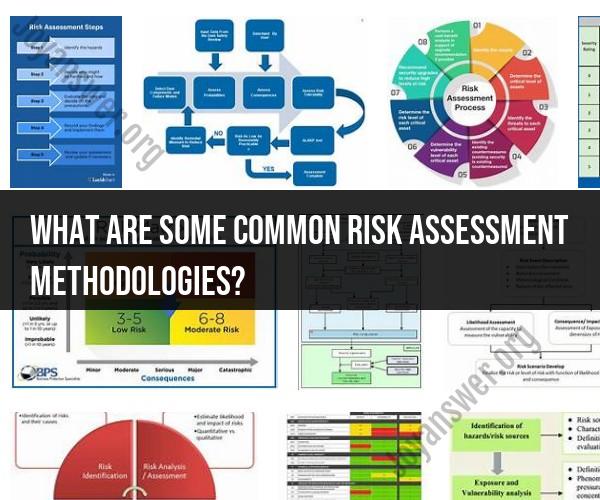What are some common risk assessment methodologies?
There are several common risk assessment methodologies used to analyze and evaluate risks in various domains, including business, healthcare, project management, and environmental safety. The choice of methodology often depends on the specific context and the nature of the risks being assessed. Here are some common risk assessment methodologies:
Qualitative Risk Assessment:
- In qualitative risk assessment, risks are evaluated based on subjective judgments and expert opinions rather than numerical data.
- Risks are typically categorized as low, medium, or high based on their potential impact and likelihood.
- This approach is often used when quantitative data is limited or when a quick assessment is needed.
Quantitative Risk Assessment (QRA):
- QRA involves the use of quantitative data and mathematical models to assess risks more precisely.
- Probabilistic risk assessment (PRA) and fault tree analysis (FTA) are examples of quantitative methodologies.
- QRA assigns numerical probabilities and consequences to risks, allowing for more rigorous analysis.
Hazard and Operability Study (HAZOP):
- HAZOP is a systematic process used primarily in the chemical and process industries to identify potential hazards in a system.
- It involves a team of experts who systematically review and analyze deviations from the intended operation of a system.
Failure Modes and Effects Analysis (FMEA):
- FMEA is a structured approach used to identify and prioritize potential failure modes of a product, process, or system.
- Each failure mode is evaluated based on its severity, likelihood, and detectability, resulting in a risk priority number (RPN).
Bowtie Risk Assessment:
- Bowtie analysis visualizes the relationship between hazards, controls, and consequences using a bowtie diagram.
- It helps identify potential barriers and controls to prevent or mitigate risks.
SWOT Analysis:
- SWOT (Strengths, Weaknesses, Opportunities, Threats) is a simple framework used in business to assess internal and external factors that may affect an organization's objectives.
- While not a traditional risk assessment, it can identify potential risks and opportunities.
Event Tree Analysis (ETA):
- ETA is used to model the possible outcomes of an initiating event by branching events and their probabilities.
- It is often used in nuclear and aerospace industries.
Scenario Analysis:
- Scenario analysis involves considering different possible future scenarios and their associated risks.
- It is commonly used in financial risk assessment and strategic planning.
Monte Carlo Simulation:
- Monte Carlo simulation is a computational technique that generates multiple random simulations to model the uncertainty and variability of risks.
- It is often used in project risk analysis and financial modeling.
Environmental Impact Assessment (EIA):
- EIA is a systematic process for identifying and evaluating the environmental consequences of proposed projects, policies, or developments.
Security Risk Assessment:
- Security risk assessments focus on identifying vulnerabilities and threats to an organization's information systems and physical assets.
- Common frameworks include ISO 27001 and NIST SP 800-30 for information security.
Healthcare Failure Mode and Effect Analysis (HFMEA):
- HFMEA is a methodology used in healthcare to identify and address potential failures in healthcare processes that could harm patients.
These are just a few examples of common risk assessment methodologies. The choice of methodology depends on the specific context, objectives, available data, and the level of precision required to assess and manage risks effectively. Organizations often combine multiple methodologies to gain a more comprehensive understanding of their risk landscape.
Common Risk Assessment Frameworks and Methodologies
There are many different risk assessment frameworks and methodologies available. Some of the most common include:
- NIST Cybersecurity Framework (CSF): The NIST CSF is a voluntary framework that helps organizations manage cybersecurity risk. It provides a set of standards, guidelines, and best practices for managing cybersecurity risk.
- ISO/IEC 27001: ISO/IEC 27001 is an international standard that provides a framework for managing information security risk. It specifies a set of requirements for establishing, implementing, maintaining, and continually improving an information security management system.
- COBIT 5 for Information Security: COBIT 5 for Information Security is a framework that provides a comprehensive approach to managing information security risk. It integrates with other COBIT 5 frameworks to provide a holistic view of IT governance and management.
- OCTAVE Allegro: OCTAVE Allegro is a risk assessment methodology that helps organizations identify, analyze, respond to, and monitor security risks. It is a flexible methodology that can be adapted to meet the specific needs of an organization.
- FAIR: FAIR is a risk assessment framework that helps organizations quantify the financial impact of cybersecurity risks. It provides a common language and approach to risk quantification, which can help organizations to make better decisions about risk mitigation.
Qualitative and Quantitative Approaches to Risk Analysis
Risk analysis can be conducted using either qualitative or quantitative methods.
Qualitative risk analysis is a subjective approach to risk analysis that uses expert judgment to assess the likelihood and impact of risks. Qualitative risk analysis is often used to identify and assess risks in areas where there is limited data or where the risks are difficult to quantify.
Quantitative risk analysis is an objective approach to risk analysis that uses data and mathematical models to assess the likelihood and impact of risks. Quantitative risk analysis is often used to assess risks in areas where there is sufficient data and where the risks can be quantified.
Choosing Appropriate Risk Assessment Methods and Tools
The best risk assessment methods and tools to use will depend on the specific needs of the organization. Some factors to consider when choosing risk assessment methods and tools include:
- The size and complexity of the organization
- The nature of the risks being assessed
- The resources available to conduct the risk assessment
- The level of precision required in the risk assessment results
If an organization is new to risk assessment, it may be helpful to start with a simple, qualitative risk assessment methodology. As the organization gains more experience with risk assessment, it can move to more complex, quantitative risk assessment methodologies.
There are a number of risk assessment tools available, both commercial and open source. Some factors to consider when choosing a risk assessment tool include:
- The features and functionality of the tool
- The ease of use of the tool
- The cost of the tool
- The level of support available for the tool
Organizations should carefully consider their needs and requirements before choosing risk assessment methods and tools. By choosing the right methods and tools, organizations can conduct effective risk assessments that will help them to identify, manage, and mitigate risks.












